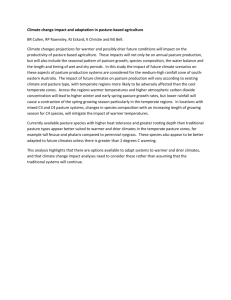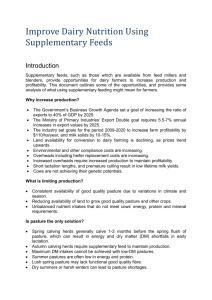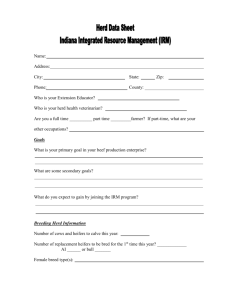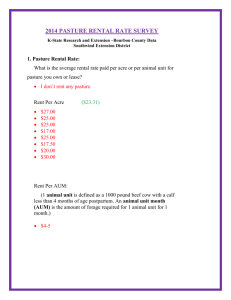Cullen et al Adapting pasture-based dairy systems to future climates
advertisement
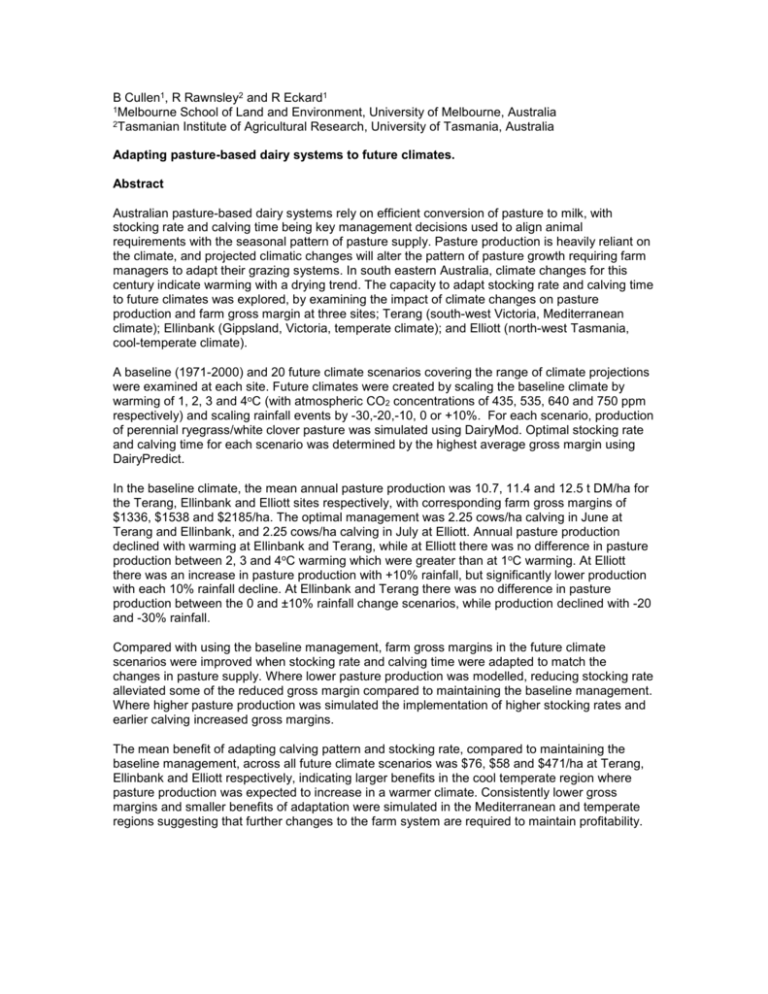
B Cullen1, R Rawnsley2 and R Eckard1 1Melbourne School of Land and Environment, University of Melbourne, Australia 2Tasmanian Institute of Agricultural Research, University of Tasmania, Australia Adapting pasture-based dairy systems to future climates. Abstract Australian pasture-based dairy systems rely on efficient conversion of pasture to milk, with stocking rate and calving time being key management decisions used to align animal requirements with the seasonal pattern of pasture supply. Pasture production is heavily reliant on the climate, and projected climatic changes will alter the pattern of pasture growth requiring farm managers to adapt their grazing systems. In south eastern Australia, climate changes for this century indicate warming with a drying trend. The capacity to adapt stocking rate and calving time to future climates was explored, by examining the impact of climate changes on pasture production and farm gross margin at three sites; Terang (south-west Victoria, Mediterranean climate); Ellinbank (Gippsland, Victoria, temperate climate); and Elliott (north-west Tasmania, cool-temperate climate). A baseline (1971-2000) and 20 future climate scenarios covering the range of climate projections were examined at each site. Future climates were created by scaling the baseline climate by warming of 1, 2, 3 and 4oC (with atmospheric CO2 concentrations of 435, 535, 640 and 750 ppm respectively) and scaling rainfall events by -30,-20,-10, 0 or +10%. For each scenario, production of perennial ryegrass/white clover pasture was simulated using DairyMod. Optimal stocking rate and calving time for each scenario was determined by the highest average gross margin using DairyPredict. In the baseline climate, the mean annual pasture production was 10.7, 11.4 and 12.5 t DM/ha for the Terang, Ellinbank and Elliott sites respectively, with corresponding farm gross margins of $1336, $1538 and $2185/ha. The optimal management was 2.25 cows/ha calving in June at Terang and Ellinbank, and 2.25 cows/ha calving in July at Elliott. Annual pasture production declined with warming at Ellinbank and Terang, while at Elliott there was no difference in pasture production between 2, 3 and 4oC warming which were greater than at 1oC warming. At Elliott there was an increase in pasture production with +10% rainfall, but significantly lower production with each 10% rainfall decline. At Ellinbank and Terang there was no difference in pasture production between the 0 and ±10% rainfall change scenarios, while production declined with -20 and -30% rainfall. Compared with using the baseline management, farm gross margins in the future climate scenarios were improved when stocking rate and calving time were adapted to match the changes in pasture supply. Where lower pasture production was modelled, reducing stocking rate alleviated some of the reduced gross margin compared to maintaining the baseline management. Where higher pasture production was simulated the implementation of higher stocking rates and earlier calving increased gross margins. The mean benefit of adapting calving pattern and stocking rate, compared to maintaining the baseline management, across all future climate scenarios was $76, $58 and $471/ha at Terang, Ellinbank and Elliott respectively, indicating larger benefits in the cool temperate region where pasture production was expected to increase in a warmer climate. Consistently lower gross margins and smaller benefits of adaptation were simulated in the Mediterranean and temperate regions suggesting that further changes to the farm system are required to maintain profitability.

